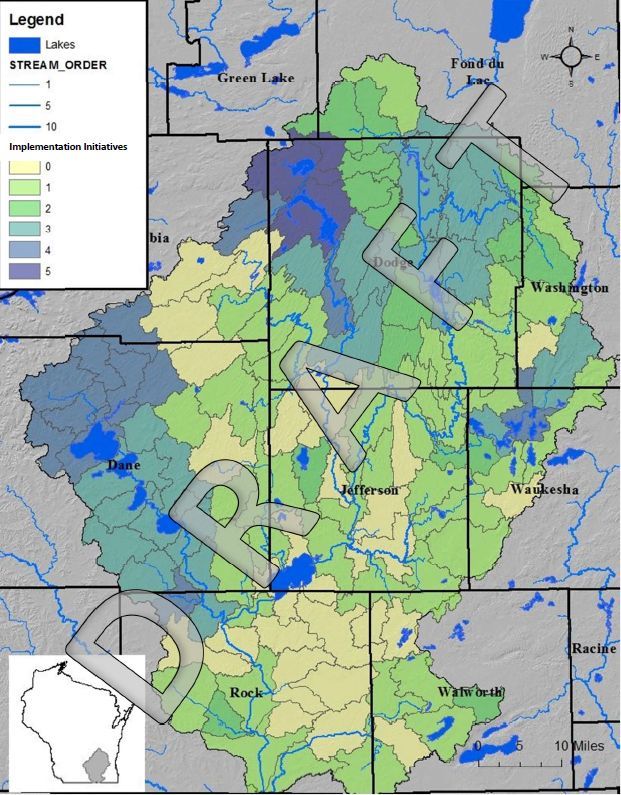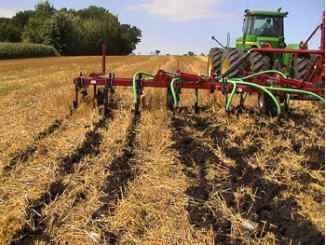 DRAFT: Rock River Basin Watersheds Ranked by Implementation Initiatives
Wisconsin’s Nutrient Reduction Strategy is a broad overview of nutrient management activities for both point sources and nonpoint sources in Wisconsin. This strategy documents ongoing activities whether they are implemented by federal, state or local agencies. It identifies areas where further progress is needed. As part of the strategy, we provide periodic updates on progress tracking, strategies, and related activities. The most recent 2017 report is available, below.
For 2019, we are currently working on summarizing efforts in Wisconsin, and especially in the top 10 focus basins, including the Rock River Basin. One effort is to better represent activities using mapping to illustrate where and how efforts are being undertaken. The above image is a draft example and ranks all of the 120 HUC-12 watersheds in the Rock River Basin based on how many of the following initiatives and activities exist within each HUC-12:
- Past Priority Watershed Restoration Project
- Current Nine-Key Element Watershed Restoration Plan
- Active Farmer-led Watershed Group
- Point Source Discharge Facility with TMDL Limits
- Watershed-based Permit Compliance Projects
We are looking for feedback/comments on this type of reporting metric. Please send comments or suggestions to Mark Riedel Rock River Recovery Project Manager.
The Wisconsin Nutrient Reduction Strategy, developed with partners and finalized in 2013, envisioned that implementation progress would be measured, tracked and reported to the public. This Implementation Progress report provides a comprehensive description of the substantial and widespread efforts to reduce nutrient losses to Wisconsin rivers, lakes and streams.

University of Wisconsin, in partnership with state and federal agencies, has developed a new publication sharing the basics of planting and growing cover crops including seeding rates, seeding depths, and timing of planting. It also covers the benefits of cover crops and things to avoid.
The publication can be viewed at: https://learningstore.extension.wisc.edu/collections/farming/products/cover-crops-101
The Natural Resources Conservation Service (NRCS) and Waupaca County Land & Water Conservation Department, in partnership with Fond du Lac, Green Lake, Marquette, Outagamie, Portage, Shawano, and Winnebago counties and the Green Lake Association, are leading a successful network, the Upper Fox-Wolf Demonstration Farm Network. The partnership is supporting ten farms that are demonstrating the best conservation practices to reduce phosphorus entering the Great Lakes basin. Click Read More below for updates from each participating farm.
|

Legacy Sediment - what is it and what can be done about it?
Dane County’s “Suck the Muck” project has received a lot of exciting attention over the past year for their legacy sediment removal in Dorn Creek where they have removed three to four feet of sediment since 2016. Now on the second phase of the project, Dane County will begin the program in Token Creek.
In this month’s Yahara Lakes 101 talk, Dane County Executive Joe Parisi and Assistant Director of Land & Water Resources John Reimer wil speak about the project expansion. Attendees will get to see the phosphorus-laden sediment islands firsthand and learn about the removal process. Ultimately, this project will divert thousands of pounds of phosphorus from entering our lakes.
|

Clean Lakes Alliance and Steve Vavarius, UW-Madison
Our climate is changing. But what are the impacts of climate change on our local communities, individual lives, and lakes?
In this month’s Yahara Lakes 101 talk, Steve Vavrus of the UW-Madison Nelson Institute for Environmental Studies will speak about the impacts of ongoing climate change on our lakes. Although lakes provide recreation, ecosystem services, and a sense of place to many Wisconsin residents, they are at risk. This presentation will highlight effects on our lakes including lake levels, ice cover, water quality, and invasive species.
|

The Wisconsin Department of Natural Resources and the Standards Oversight Council (SOC) are seeking volunteer technical experts to participate in developing a new technical standard related to avoiding and minimizing impacts to waterways and wetlands during underground utility construction. The Work Team will create a new technical standard that provides criteria for projects employing horizontal directional drilling, including procedures and practices to minimize potential for inadvertent releases associated with horizontal directional drilling and to respond to releases when they do happen.
Who Should Apply
SOC welcomes applications from all individuals with relevant experience in horizontal directional drilling, geotechnical engineering, underground utility construction, wetland and waterway hydrology, or related fields.
How to Apply
For more information and the application form, visit: https://socwisconsin.org/?p=162011
Applications are due to the SOC Program Manager at soc@wisconsinlandwater.org by midnight Tuesday, Sept. 3, 2019.
This popular annual event has been hosted since 2005 in partnership with the American Excelsior Company ErosionLab, one of only a few erosion control testing laboratories in the U.S. This event allows attendees to learn from experienced professionals in the morning classroom session and view product testing under a variety of control measures set up as stations around the facility during the afternoon field session. Read more...
|

Have you ever wondered what a wastewater treatment plant actually does? Or, perhaps, how they are regulated? What are the skill-sets of a Superintendent or Wastewater Operator? While the science and engineering of wastewater treatment can get very complex, there are a number of resources out there that can help a lay-person better understand what exactly goes into wastewater treatment. Among these are the Wastewater Study Guides. While these guides are intended for certified Wastewater Treatment Plant Operators, the following provide high-level information that can provide a peak into the intriguing science and engineering that allows us to recycle our water and return it to our streams and lakes:
|

Apply Through September 30 to be Eligible
Due to the recent catastrophic flooding events, Congress has provided the U.S Department of Agriculture Natural Resources Conservation Service in Wisconsin with over $7 million for the Emergency Watershed Protection Program-Floodplain Easements (EWPP-FPE). The program’s focus is to provide landowners with another option for those frequently flooded agricultural fields. Forested land, fallow land and pasture are also eligible, either alone or as part of a larger parcel, however, flooded cropland in the floodplain is the program’s primary focus. Read more...
|
|